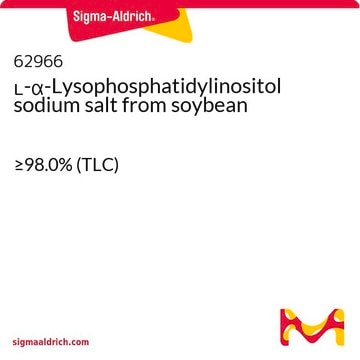We have calculated a value of 605.1, based on the structure of phosphatidyl-1-inositol and the assumption that the main fatty acids present as part of the structure are C16:0 (58%) and C18:0 and C18:2 (42%).
L7635
L-α-Lysophosphatidylinositol sodium salt from Glycine max (soybean)
≥96%
Synonym(s):
1-Acyl-sn-glycero-3-phospho-(1-D-myo-inositol)
About This Item
Recommended Products
biological source
soybean
Quality Level
Assay
≥96%
form
powder
functional group
phospholipid
lipid type
phosphoglycerides
shipped in
ambient
storage temp.
−20°C
Application
Biochem/physiol Actions
Quality
Preparation Note
Storage Class Code
11 - Combustible Solids
WGK
WGK 3
Flash Point(F)
Not applicable
Flash Point(C)
Not applicable
Personal Protective Equipment
Choose from one of the most recent versions:
Certificates of Analysis (COA)
Don't see the Right Version?
If you require a particular version, you can look up a specific certificate by the Lot or Batch number.
Already Own This Product?
Find documentation for the products that you have recently purchased in the Document Library.
Customers Also Viewed
-
What is the molecular weight of L-α-Lysophosphatidylinositol sodium salt from Glycine max, Product L7635?
1 answer-
Helpful?
-
-
What is the Department of Transportation shipping information for this product?
1 answer-
Transportation information can be found in Section 14 of the product's (M)SDS.To access the shipping information for this material, use the link on the product detail page for the product.
Helpful?
-
-
What fatty acid groups does L-α-Lysophosphatidylinositol sodium salt from Glycine max, Product L7635, contain?
1 answer-
The main fatty acid group is palmitic acid. The next most abundant fatty acid groups tend to be stearic acid and linolenic acid, and then oleic acid and linoleic acid.
Helpful?
-
Active Filters
Our team of scientists has experience in all areas of research including Life Science, Material Science, Chemical Synthesis, Chromatography, Analytical and many others.
Contact Technical Service












